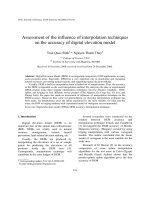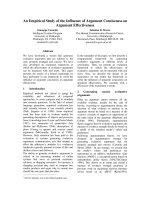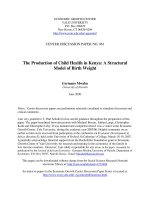Influence of Birth Weight on Mortality From Infectious Diseases: A Case-Control Study
Bạn đang xem bản rút gọn của tài liệu. Xem và tải ngay bản đầy đủ của tài liệu tại đây (1001.4 KB, 7 trang )
Influence of Birth Weight on Mortality From Infectious Diseases: A Case-Control
Study
C. G. Victora, P. G. Smith, J. P. Vaughan, L. C. Nobre, C. Lombardi, A. M. B. Teixeira, S.
M. Fuchs, L. B. Moreira, L. P. Gigante and F. C. Barros
Pediatrics 1988;81;807
The online version of this article, along with updated information and services, is located on
the World Wide Web at:
/>
PEDIATRICS is the official journal of the American Academy of Pediatrics. A monthly publication,
it has been published continuously since 1948. PEDIATRICS is owned, published, and trademarked
by the American Academy of Pediatrics, 141 Northwest Point Boulevard, Elk Grove Village,
Illinois, 60007. Copyright © 1988 by the American Academy of Pediatrics. All rights reserved. Print
ISSN: 0031-4005. Online ISSN: 1098-4275.
Downloaded from pediatrics.aappublications.org at Viet Nam:AAP Sponsored on March 3, 2013
Influence
Infectious
c. G. Victora,
L. . Nobre,
S. M. Fuchs,
F. C. Barros,
of Birth Weight on Mortality From
Diseases:
A Case-Control
Study
MD, PhD, P. G. Smith, DSc, J. P. Vaughan,
MD,
MD, C. Lombardi,
BSc, A.M.B.
Teixeira,
MD,
MD, L. B. Moreira,
MD, L. P. Gigante,
MD, and
MD, PhD
From the Department
of Social
Medicine,
Faculty
of Medicine,
Federal
University
of Pelotas,
Pelotas,
RS, Brazil,
and the Tropical
Epidemiology
Unit and the
Evaluation
and Planning
Centre,
London
School
of Hygiene
and Tropical
Medicine,
London
ABSTRACT.
The association
between
birth weight
and
infant mortality
from infectious
diseases
was investigated in a population-based
case-control
study in two
urban areas in southern
Brazil. All deaths of children,
seven
to 364 days
of age,
occurring
in a year
were
stud-
ied and the parents
of the 357 infants
dying of an infectious cause were interviewed,
as were the parents
of
two neighborhood
control
infants
for each case. Low
birth
weight
infants
(<2,500
g) were
found,
after
a!-
lowing for confounding
factors,
to be 2.3 (90% confidence interval
=
1.6 to 3.4) times more likely to die of
an infection
than
those
ofhigher
birth
weight.
The
odds
ratios were 2.0 (1.1 to 3.6) for deaths due to diarrhea,
1.9 (1.0 to 3.6) for respiratory
infections,
and 5.0 (1.3
to 18.6) for other infections.
These estimates
ofthe risks
associated
with low birth weight are considerably
lower
than those from studies
in developed
countries.
Pediatrics
1988;81:807-811;
birth weight,
infant
mortality,
infectious
disease,
diarrhea,
respiratory
infection.
Low birth
weight
is associated
with
an increased
risk of infant
mortality
in both developed
and developing
countries.
For the latter,
however,
there
is little information
concerning
the risks associated
with low birth
weight
for specific
causes
of death
and, in a recent
review
of mortality
due
to diarrhea,
the authors1
reported
that they were
unable
to locate
any studies
concerning
the effect
of birth
weight.
The lack of information
is probably
due to two
factors.
First,
in many
developing
countries
the
Received
26, 1987; accepted
July 31, 1987.
Department
of Social Medicine,
Federal
University
of Pelotas,
CP 464, 96100 PS, Brazil.
PEDIATRICS
(ISSN
0031 4005).
Copyright
© 1988 by the
American
Academy
of Pediatrics.
Reprint
for publication
requests
May
to (C.G.V.)
proportion
of
babies
delivered
in
hospitals
is
small;
therefore,
birth
weight
data are not available for a large proportion
of infants.
Second,
obtaming
reliable
information
about
mortality
is
difficult
and usually
requires
that
a monitoring
system
essary
the
the
is set up.
to consult
parents
probable
of the
cause
Whether
increased
sess
Furthermore,
medical
low
because
deceased
of death.
birth
infant
children
weight
mortality
there
it may then
be necrecords
and
interview
are
itself
may
several
to ascertain
is a cause
of
be difficult
to as-
demographic,
so-
cioeconomic,
and environmental
factors
that may
confound
the association.
For example,
infants
from low-income
families
may have
lower
birth
weights
and also be more likely
to die due to infectious
diseases
for reasons
other
than low birth
weight.2
Failing
to take into account
such factors
might
lead to biased
results.
We have tried to overcome
these
difficulties
by
conducting
a case-control
study
in a defined
population
of urban
children,
where
nearly
all births
occur in a hospital.
Extensive
data were collected
concerning
factors
that
might
confound
the association
between
birth weight
and infectious
disease mortality.
POPULATION
AND METHODS
The study
was carried
out in the metropolitan
areas
of Porto
Alegre
and Pelotas.
These
cities
have a total population
of 2.5 million
and are located in the state of Rio Grande
do Sul, one of the
most developed
areas
of Brazil.
The infant
mortality
rate in Pelotas
is about
40/1,000,2
and approximately
9% of the babies
are of low birth
Vol. 81
No. 63,June
Downloaded from pediatrics.aappublications.org at VietPEDIATRICS
Nam:AAP Sponsored
on March
2013 1988
807
weight
(ie, <2,500
g).3 Statistics
for Porto
Alegre
are likely
to be similar.
Between
Dec 24, 1984,
and Dec 23, 1985,
all
hospitals,
coroner
services,
health
authorities,
and registries
in the cities were visited
weekly
to
gather
information
about
deaths
occurring
to infants resident
in the study areas.
This method
has
been
shown
to ascertain
the majority
of such
deaths.2’4
Whenever
an infectious
disease
was
mentioned
as the underlying
or associated
cause
of death,
or when
the cause
of death
was ill-defined or not stated,
the parents
or guardian
of the
deceased child were visited
and questioned
to investigate
the
underlying
cause.
Of
all
potential
deaths,
96.5%
were successfully
located.
During
the home visit, the interviewer,
a physician,
questioned
the parents
regarding
the signs and symptoms
of the
illness
episode
that
preceded
the
child’s
death.
Further
information
was abstracted
from the hospital
case notes,
from health
center
records,
and from postmortem
reports.
The questionnaires
and forms
completed
were those
used
in the Inter-American
Investigation
of Mortality
in Childhood.5
Two reviewers
went
through
the
interview
and clinical
data
independently
to assess
the
underlying
causes
of death.
If there
was
any
disagreement,
a third reviewer
(C.G.V.)
made
the final decision.
The three
reviewers
were kept
unaware
of the infant’s
birth
weight.
Causes
of
death
were
classified
according
to the International
Classification
ofDiseases,
9th rev (lCD).6
The study was designed
primarily
to investigate risk factors
for post-perinatal
infant
mortality, and children
dying
before
the eighth
day of
life were
excluded.7
In addition,
infants
at increased
risk of perinatal
morbidity
and mortality
(multiple births, major congenital
malformations
or cerebral
palsy)
were
also excluded,
as were
those whose initial
hospital
stay exceeded
15 days
and those ofvery
low birth weight
(<1,500
g; 1.4%
of births).
These
criteria
excluded
14% of infants
who might
potentially
die between
seven
and 364
days.
For each case infant,
two neighborhood
control
infants
were selected,
the first being
the nearest
neighbor
seven to 364 days ofage
and, the second,
the next child in the neighborhood
seven
days to
<6 months
of age. Because
three
quarters
of the
infants
were
expected
to be younger
than
6
months,
this approach
was designed
to provide
a
control
group
with
a similar
age distribution
to
that of the case infants.
The same rigorous
efforts
aimed
at locating
all babies
were
used to interview all of the eligible
control
infants,
including
repeated
visits
Information
tamed
808
from
if necessary.
regarding
hospital
INFECTIOUS
birth
discharge
DISEASES
weight
cards
was
(available
ob-
for
61% of the infants)
or by recall.
Birth
weights
were not recallable
by 1.4% of the mothers.
Information
was also collected
about
variables
that
may
confound
the
association
between
birth
weight
and mortality.
These
included
the infant’s
age and sex, birth
order,
birth
intervals,
family
income,
occupation
and education
of the parents,
ethnic
group,
maternal
age and smoking
habits,
housing,
crowding,
water
and
sanitation
vanables,
antenatal
cane, and type of delivery.
Initial
tabulations
were
conducted
to assess
which
variables
were associated
both with birth
weight
among
the control
infants
and with
the
risk of death.
Such variables
were considered
as
potential
confounders
and were further
analyzed
through
logistic
regression
for matched
studies.8
Analyses
were carried
out independently
for each
of the three
groups
of causes
(diarrhea,
respiratory infections,
and other
infections).
The infants’
age(coded0to2,2to4,4to6,6to9,and9to
11 months),
family
income
(0 to 0.2, 0.2 to 0.4, 0.4
to 1.0, 1.0 + minimum
wages
per capita),
and maternal
education
(0, 1, 4, 6 + years)
were
adjusted
for in all analyses.
In addition,
the following
vanables remained
statistically
significant
in the conditional
likelihood
analysis:
(1) deaths
due to diarrhea:
availability
of piped
water
(piped
in house,
piped to plot, other),
maternal
smoking
(cigarettes
per day), and preceding
birth
interval
(first born,
0 to 24, 24 to 36, 36 + months);
(2) deaths
due to
respiratory
infection:
sex,
maternal
age
(years)
and
smoking,
and birth
order (0, 1, 2, 3 to 5, 5 +);
(3) deaths
due to other
infections:
availability
of
piped water.
The effect
of birth
weight
was assessed
after
including
these confounding
factors
in the logistic
model.
One-sided
tests
of significance
were used
because
it was expected
that
low birth
weight
would
increase
the risk of death.
The study
was of sufficient
size to have a power
of 95% to detect
as statistically
significant
at the
5% level (one-tailed
test) a trebling
of the risk of
death
among
low birth
weight
infants,
assuming
that
9% of the control
children
would
be of low
birth
weight.
For this purpose,
121 case infants
would be necessary
in each diagnostic
group.
This
number
was achieved
for deaths
due to diarrhea
and respiratory
infections,
but there
were only 60
deaths
due to other
infections.
The power
of the
study
of other
infections,
was
reduced,
therefore,
to 73%.
RESULTS
The 357 deaths
due to infectious
diseases
were
grouped
into
three
categories:
diarrhea
(170
deaths,
lCD
001_0096),
respiratory
infections
AND MORTALITY
Downloaded from pediatrics.aappublications.org at Viet Nam:AAP Sponsored on March 3, 2013
(127
deaths,
lCD
382,
460-466,
480-487,
income
Table
The
519.8),
and
mon
gitis
(ten
other
infections
(60 deaths).
The most comdiagnoses
in the latter
group
were menin(12 deaths,
lCD 320-322),
skin
infections
deaths,
lCD 682, 684), measles
(eight
deaths,
lCD 055), whooping
cough
(seven
deaths,
lCD
033), neonatal
sepsis
(six deaths,
lCD 771.8),
and
tuberculosis
(5 deaths,
lCD 010-018).
The distributions
of case and control
children
by age, sex,
TABLE
1
Distribution
.
oflnfants
trols
and
maternal
education
1.
birth weight
distributions
are
in
Table
2.
(eight
with
four control
analyses,
fants
to
have
been
assigned
category
(3,000
to Age, Sex, Family
to 3,499
Income,
shown
ofcases
Weights
recorded
for 11 case infants
three with respiratory),
and
In the table and in subsequent
weight
According
shown
are
the
in
and
con-
were
not
diarrhea,
children.
these
in-
modal
g). Excluding
birth
such
and Maternal
Education
%
Variable
0
f Infants
Diarrhea
(n = 170)
Dying
Due
% of
Control
Infants
to:
Respiratory
Infections
(n = 127)
Other
Infections
(n = 60)
714)
Age (mo)
10
32
25
27
7
10
39
24
19
9
Male
58
Female
Income*
42
0-0.19
0.2-0.39
0.4-0.99
0-1.9
2-3.9
4-5.9
6-8.9
9-11.9
35
15
20
18
12
22
26
21
15
16
58
52
52
42
48
48
22
38
27
27
29
32
23
20
37
16
34
28
12
12
20
22
Sex
1.0
Maternal
None
*
education
(yr)
13
17
15
11
1-3
36
33
22
27
4-5
6
35
17
30
20
37
27
35
28
Monthly
TABLE
per
2.
by Groups
capita
inco me in minimum
Odds Ratios
of Causes
for
Infectious
Odds
Cause
of Death
and Birth
Wt
Adjusted
wages
(1 minimum
Diseases
Ratio
(90%
for Age
Mortality
Confidence
wage
ng
Accordi
$50).
to Birth
Weight,
No. of Infants
Interval)
Adjusted
for Age
and Confounders*
(g)
US
=
Case
Control
Diarrhea
<2,500
2,500-2,999
3,000-3,499
3,500
Respiratory
2.2 (1.1-4.5)
1.2 (0.6-2.1)
1.1 (0.6-1.8)
31
45
61
25
90
136
1.0
1.0
33
89
2.6 (1.3-5.2)
2.0 (1.1-3.7)
1.5 (0.9-2.6)
3.3 (1.5-7.5)
2.3 (1.1-4.8)
2.0 (1.0-3.8)
22
41
46
24
65
101
1.0
1.0
18
64
9
21
19
11
3
27
54
36
infections
<2,500
2,500-2,999
3,000-3,499
3,500
Other infections
<2,500
2,500-2,999
3,000-3,499
8.6 (2.4-30.4)
2.7 (1.2-6.0)
1.5 (0.7-3.4)
3,500
*The
3.4 (1.9-6.2)
1.7 (1.0-2.7)
1.2 (0.8-1.9)
12.8 (2.6-62.6)
4.5 (1.6-12.4)
1.9 (0.7-5.1)
1.0
following
confounding
to age, family
income,
of piped
water,
and
and smoking,
1.0
variables
were
included
in the
logistic
and maternal
education:
for diarrhea,
birth
maternal
smoking;
for respiratory
infections,
and birth
order;
for other
infections,
availability
model,
interval,
sex,
of piped
in addition
availability
maternal
age
water.
ARTICLES
Downloaded from pediatrics.aappublications.org at Viet Nam:AAP Sponsored on March 3, 2013
809
infants
from the analyses
did not affect
the findings.
For each of the three
causes
of death
considered,
the odds ratios
for mortality
increased
monotonically
as birth
weight
decreased,
and in
each case the trend
was statistically
significant.
Controlling
for confounding
variables
resulted
in
some
changes
to the risk estimates
but did not
alter
the main
findings.
After
such adjustment,
infants
weighing
less than 2,500 g at birth
were
found to be 2.2, 3.3, and 12.8 times
more likely
to
die due to diarrhea,
respiratory
infections,
and
other infectious
diseases,
respectively,
than those
weighing
more than
3,500 g.
The
risks
associated
with
different
birth
weights
were
examined
in smaller
intervals
by
pooling
deaths
due to all types
of infection
(Figure). The risk ofdeath
did not vary much for children weighing
more than
3,000 g at birth.
It increased
slightly
for children
weighing
2,500
to
2,999 g. Infants
weighing
2,000
to 2,499
g were
at about
twice the risk, and those
1,500 to 2,000
g were
at nine
times
the
risk
ofchildren
more
than
3,000 g.
Compared
with infants
who weighed
2,500 g or
more at birth,
low birth
weight
infants
were 2.0
times
(90% confidence
interval
1.1 to 4.4) more
likely
to die of diarrhea,
1.9 times
(1.0 to 3.6) as
likely to die of respiratory
infections,
and
5.0
times
(1.3 to 18.6) as likely
to die of other
infections.
For all infections,
the odds ratio
for low
birth
weight
babies
was 2.3 (1.6 to 3.4). We tested
for interactions
of the effects
on mortality
of age
Odds
Ratio
40
20
10
2
S
0.5
1500-
2000-
2500-
Figure.
Odds
mortality
due
ratios
and
to infectious
3000-
3500-
4000+
(grams)
BIRTHWEIGHT
90%
confidence
diseases
according
intervals
for
to birth
weight
(adjusted
for age, sex, family income, birth interval,
birth order, availability
of piped water, maternal education,
age, and smoking),
Rio Grande
do Sul,
Brazil.
810
INFECTIOUS
DISEASES
and birth
weight
and socioeconomic
status
and
birth weight.
There
was no evidence
that the relative magnitude
of the effect
of birth
weight
on
infectious
diseases
mortality
changed
during
the
first
year
the
effects
of life,
and
varied
there
was
according
no
to
evidence
that
socioeconomic
group.
DISCUSSION
In this study,
low birth
weight
was found to be
associated
with an increased
risk of death
due to
infectious
diseases,
and the association
persisted
after
allowing
for confounding
variables.
The
risks
associated
with
low
birth
weight
be larger
seemed
to
for deaths
from other infections
than for
diarrhea
or respiratory
infections,
but the confidence
intervals
on the estimated
relative
risks
were
wide.
The risks
were
considerably
lower
than
would
have
been
expected
from
previous
studies
of postneonatal
mortality
from all causes,
which suggested
a fivefold
increase
for low birth
weight
infants.’
The choice ofneighbors
as controls
ensured
that
the control
group
was of broadly
similar
socioeconomic
status
to that
of the case group.
Furthermore,
by adjusting
for several
confounding
vanables in the analyses,
we endeavored
to separate
out the effects
of birth
weight
which
otherwise
would have been confused
with effects
due to other
factors.
In general
we would
expect
this method
of design
and analysis
to result
in lower (and betten) risk
estimates
than
those
derived
from investigations
in which
such procedures
were
not
followed,
as is the case for previous
studies.
We
decided not to adjust for feeding
mode, because
we
had previously
shown
that birth
weight
is one of
the
determinants
of the
duration
of breastfeeding.9
Our risk estimates
are likely
to have
been
biased
toward
unity
by our exclusion
of very low
birth
weight
infants
and those
infants
with significant
risk of peninatal
morbidity
or congenital
malformations.
It is unlikely
that this will have
biased
the findings
seriously.
For example,
if one
half of the excluded
babies
were
of low birth
weight,
the risk
estimates
associated
with
low
birth
weight
would
have
increased
by 35% had
they been included
in the study.
If two thirds
of
those
excluded
had a low birth
weight,
the increase
would
be of about
50%. On the other hand,
excluding
some of these high-risk
babies
was also
a strategy
for the control
of confounding.
For example,
an infant
with
a major
malformation
would
be more
likely
to have
a low birth
weight
and also more
likely
to die due to an infectious
AND MORTALITY
Downloaded from pediatrics.aappublications.org at Viet Nam:AAP Sponsored on March 3, 2013
disease,
outcomes.
the
malformation
being
the
cause
of both
We used birth weight data that were routinely
collected,
and nearly
40% of the information
was
based
on recall.
We have shown
previously,
however, that even 1 year after delivery
mothers
were
able to recall the birth weight
oftheir
infants
with
good
The likely
effect
of recall
and
measurement
errors
would
be to lead to an underestimate
of the true relative
risks.
It should
be
noted,
however,
that
most of the previous
work
reporting
higher
relative
risks
for infant
mortality due to low birth weight
has been based on data
that were also collected
routinely.
The impact
oflow
birth
weight
might
be erased
quickly
if these
infants
grew
faster
than
those
born
with
an adequate
weight.
However,
in an
earlier
cohort
study
in the same
population,
we
have shown
that this is not the case.”
Low birth
weight
infants
tended
to put on less weight
during
the first year,
although
the differences
were
no
longer
significant
after
adjustment
for family
income.
We believe,
therefore,
that
the effect
of low
birth
weight
on infectious
diseases
mortality
in
the population
we studied
is not as marked
as that
reported
for overall
infant
or postneonatal
mortality
fact
from
in
developed
that,
when
developed
mortality
in
countries.
compared
countries,
developing
This
is due
with
similar
the relative
countries
are
to
the
infants
risks
of
higher
for
infants
born with an appropriate
weight
than for
those
with a low birth
weight.2
This is in agreement
with our previous
finding
of an interaction
between
birth weight
and socioeconomic
status
on
infant
mortality
due to all causes,
with the nelative risks
associated
with low birth
weight
being
higher
for high-income
than
for low-income
infants,
deaths
among
the former
being
due most
often to noninfectious
causes.2
Based on the odds ratios
presented,
it is possible
to calculate
the proportion
of deaths
that may be
attributed
to a low birth
weight
(assuming
a
causal
association).
These
are 8% for diarrhea,
7%
for respiratory
infections,
26% for other
infec-
tions,
and
10%
for
all
infections.
Thus,
if our
risk
estimates
are correct,
low birth
weight
is associated with a small proportion
ofdeaths
due to diarrhea and respiratory
infections
and for about
one
fourth
of those due to other infections.
These
findings suggest
that estimates
ofthe
possible
impact
of improving
birth
weight
on mortality
rates
in
the developing
world or, at least in southern
Brazil, may be less than
has been estimated,
based
on data from developed
countries.
ACKNOWLEDGMENTS
The
opment
study
was
Research
funded
Center
by the
International
Devel-
of Canada.
REFERENCES
1. Ashworth
A, Feachem
RG: Strategies
for the control
of
diarrhoeal
diseases:
The prevention
of low birthweight.
Bull WHO
1984;62:271-291
2. Victora
CG, Barros
FC, Vaughan
JP, et a!: Birthweight
and infant mortality:
A study of 5914 Brazilian
children.
mt J Epidemiol
1987;16:239-245
3. Barros
FC, Victora
CG, Vaughan
JP, et a!: Bajo peso a!
nacer en el municipio
de Pelotas,
Brasil:
Factores
de
riesgo.
Bol ofSanit
Partam
1987;102:541-553
4. Victora
CG, Vaughan
JP, Barros
FC: Seasonality
of infant
death due to diarrhoea!
and respiratory
diseases in southem Brazil
1974-78.
Pan
Am
Health
Organ
Bull
1985;19:29-39
5. PufFer RR, Serrano
CV: Patterns
ofMortality
in Childhood,
scientific
publication
No. 262. Washington,
Pan American
Health
Organization,
1975
6. World Health Organization:
International
Statistical
Classification
ofDiseases,
Injuries
and Causes
ofDeath,
rev 9.
Geneva, WHO,
1975
7. Victora
CG, Smith
PG, Vaughan
JP, et a!: Evidence
for a
strong
protective
effect
of breastfeeding
against
infant
deaths
from
infectious
diseases
in Brazil.
Lancet
1987;2:319-322
8. Storer
B, Wacholder
S, Breslow
NE: Maximum
likelihood
fitting
of general
risk models
to stratfied
data. Appl Stat
1983;32:172-181
9. Barros
FC, Victora
CG, Vaughan
JP, et a!: Birth weight
and the duration
of breast-feeding:
Are the beneficial
effects of breast-feeding
being
overestimated?
Pediatrics
1986;78:656-661
10. Victora
CG, Barros
FC, Martines
JC, et al: As maes lembram o peso ao nascer
de seus filhos? Rev Saude Publica
Sao Paulo 1985;19:195-200
11. Victora
CG, Barros FC, Vaughan
JP, et a!: Birthweight,
socio-economic
status
and growth
of Brazilian
infants.
Ann Hum Biol 1987;14:49-57
Downloaded from pediatrics.aappublications.org at Viet Nam:AAP Sponsored on March 3,ARTICLES
2013
811
Influence of Birth Weight on Mortality From Infectious Diseases: A Case-Control
Study
C. G. Victora, P. G. Smith, J. P. Vaughan, L. C. Nobre, C. Lombardi, A. M. B. Teixeira, S.
M. Fuchs, L. B. Moreira, L. P. Gigante and F. C. Barros
Pediatrics 1988;81;807
Updated Information &
Services
including high resolution figures, can be found at:
/>
Citations
This article has been cited by 6 HighWire-hosted articles:
/>
Permissions & Licensing
Information about reproducing this article in parts (figures, tables)
or in its entirety can be found online at:
/>
Reprints
Information about ordering reprints can be found online:
/>
PEDIATRICS is the official journal of the American Academy of Pediatrics. A monthly publication, it
has been published continuously since 1948. PEDIATRICS is owned, published, and trademarked by the
American Academy of Pediatrics, 141 Northwest Point Boulevard, Elk Grove Village, Illinois, 60007.
Copyright © 1988 by the American Academy of Pediatrics. All rights reserved. Print ISSN: 0031-4005.
Online ISSN: 1098-4275.
Downloaded from pediatrics.aappublications.org at Viet Nam:AAP Sponsored on March 3, 2013









